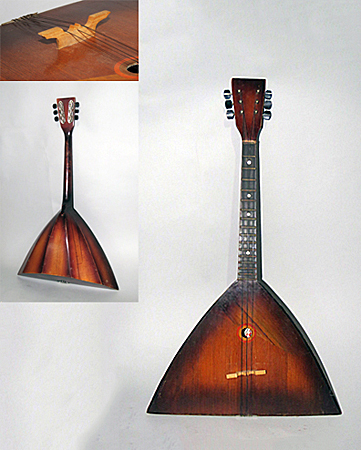
Owner: HWMC
Catalog#: CL-CHLT-31
Miscellaneous Lutes
Russian 'Balalaika' - Prima
Russia
Unknown
Wood, metal,
1917 C.E.
Height: 26.75 in
Strings – Lutes – Miscellaneous Lutes
Label inside: Written in Russian with the date 1917
The balalaika is a Russian long neck chordophone with a characteristic triangular wooden, hollow body, fretted neck and three strings. The soundboard consists of Russian spruce or silver fir with a small sound hole in the center. The back consists of maple. The higher-pitched balalaikas are used to play melodies and chords. The balalaika family of instruments vary in sizes, from the highest-pitched to the lowest: the piccolo balalaika, prima balalaika, secunda balalaika, alto balalaika, bass balalaika, and contrabass balalaika.
This six-string prima balalaika is factory made with a label inside and is the most common solo instrument. It has three sets of double courses, similar to the strings of the mandolin and often uses a ‘guitar’ turning of G3-B3-D4, rather that the three string prima that is tuned to E4–E4–A4, where the lower strings are traditionally tuned to the same pitch. The prima balalaika, along with the secunda and alto are played either with the fingers or a plectrum (pick), depending on the music being played.
The balalaika is possibly related to the Central Asian ‘dombra,’ an instrument from the East Slavs, and was first noted in literature around 1688. In 1715, Peter the Great used balalaikas in his grand orchestral procession. It was a popular village instrument among the free-lance musical jesters for centuries. During the 1880s, Vasily Vasilievich Andreyev, a professional violinist in the music salons of St Petersburg, developed what became the standardized balalaika, with the assistance of violin maker V. Ivanov. With the establishment of the Soviet Union (1922-1991), the government actively supported the proletarian movement (working class) and their balalaika orchestras.
Resource: ‘Balalaika,’ Martin Kiszko, “The Grove Dictionary of Musical Instruments,” 2nd ed., Laurence Libin, Editor-in-Chief, Oxford University Press, 2014, Vol. I, pp.181-182.
